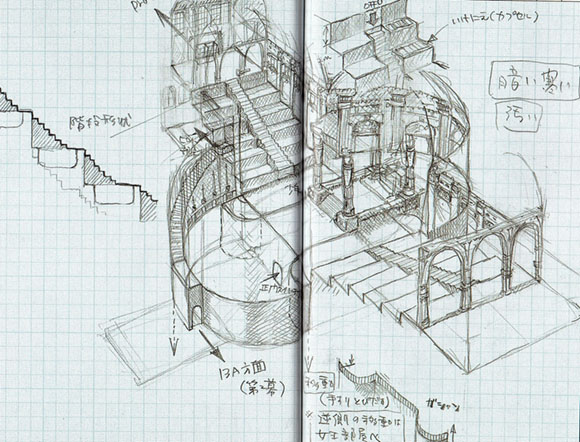A friend of mine recently bought the Japanese version of the ICO & Shadow of the Colossus HD Remix for me. I already had the western version. But the Japanese version has one great detail the western one has not: a beautiful, little behind-the-scenes booklet.

Good job, Sony. I’m sure that’s something the western audience wouldn’t have appreciated.
It’s a rather small booklet but it contains some amazing concept art that reveals some interesting details about how the game was made. Here are some of my favorites.

Click here to enlarge.
There are multiple pictures like the one above. I think this one shows an early version of the first room in ICO – the sacrificial chamber you start out in. It has the throne for the final boss. It also has the movable floor that made it into the final game. Interestingly, in the final game the throne was moved into a separate room. What remained is the idea that you go full circle. The hero needs to turn around and return to the room he finished his adventure in to face the final challenge. It seems like that idea was there from a very early stage.
What I really like about that piece is that it’s drawn on millimeter-paper. Seems like a pretty unusual and hardcore way to do artwork in. Considering how the illustration contains profile-cutaways, it kinda makes sense. I also love the isometric perspective with selectively removed walls. It does a really wonderful job at conveying the space.

Click here to enlarge.
Here is an interesting drawing of the capsule the hero in ICO starts out in. A remarkable attention to detail of you consider that the capsule is visible for only a few seconds in the game. I love the fact that it’s mechanically sound. The arm restrain folds away to the side only if the capsule is opened. Otherwise, the restrain will press against the capsule walls and won’t be able to swivel up.

Click here to enlarge.

Click here to enlarge.
The two above images are probably my highlight of the booklet. The drawings describe in in painstaking detail the interaction between the hero and Yorda. Individual animation phases are described. There is a diagram showing the range of motion for the hero’s arm – apparently useful for hand-holding mechanics. There is a diagram showing how the call button works depending on how far the two characters are apart. It even shows what kind of hand movement the hero does when calling Yorda.
The millimeter-paper totally makes sense in this regard. It’s a good way to keep all the drawings in a comparable scale. I wonder how well all this pre-planning translated into actual gameplay. Was Fumito Ueda really able to design this all on paper or was this already informed by some preliminary playtesting? Did all of this just work or did they have to tweak the scales and proportions during implementation?

Click here to enlarge.
Finally, something from Shadow of the Colossus. The drawing shows different stages of a boss from Shadow of the Colossus. This time the grid is not as fine. It looks like regular 5mm quadrille. It still clearly helps to keep the drawings to scale. The individual frames indicate opportunities to attack the monster as well as interaction with the environment. Which I guess is the real advantage of planning the battle ahead of time like this. Technically difficult events can be tested with no effort at all. I wonder if every boss battle in the game was pre-planned like this.
Overall, the booklet is not that large or comprehensive. But for a true Fumito Ueda enthusiast, the Japanese version certainly is a valuable and fascinating collector’s item.





